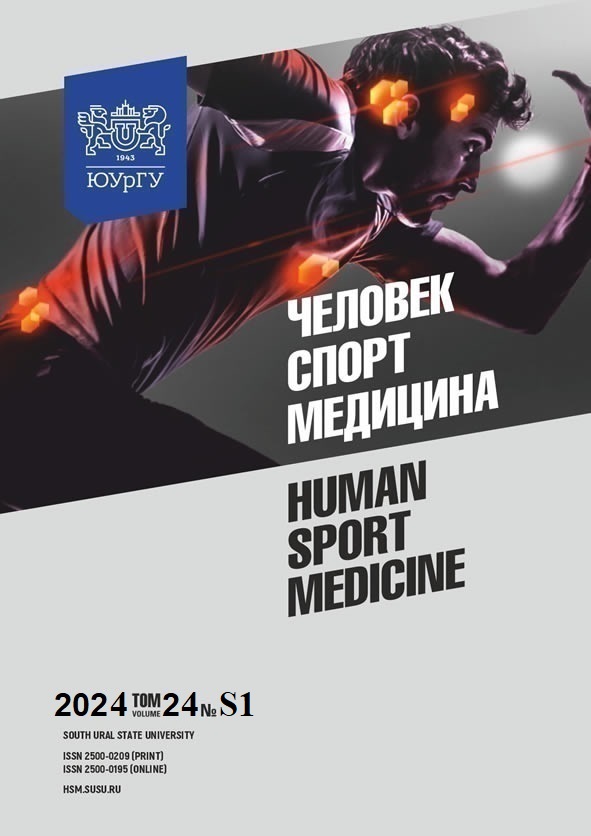ФУНКЦИОНАЛЬНАЯ МОДЕЛЬ ВЫПАДОВ ПРОФЕССИОНАЛЬНЫХ СПОРТСМЕНОВ-ВОЛЕЙБОЛИСТОВ
Аннотация
Цель: построение биомеханической модели выпадов у профессиональных спортсменов волейболистов для оценки функциональности голеностопного сустава. Материалы и методы. Субъектами исследования являлись профессиональные спортсмены-волейболисты от 14 до 18 лет и группа неспортсменов от 18 до 23 лет (контроль). Исследование проводилось в соответствии с этическими принципами Хельсинской декларации проведения медицинских исследований с участием людей в качестве субъектов исследования. Участники были информированы о ходе тестирования и предоставили добровольное согласие. Для построения модели использовали программу Vicon nexus с использованием светоотражающих маркеров, которые размещались в проекции суставов, и снималась с шести камер Vicon MX амплитуда движения в голеностопном суставе. Результаты. В целом группа спортсменов-волейболистов продемонстрировала больший диапазон движений при тыльном сгибании голеностопного сустава, чем контрольная группа. Эксцентрическая работа мышц подошвенного сгибателя голеностопного сустава может способствовать снижению силы опоры при подходе переднего отдела стопы с большим углом к полу по сравнению с меньшим углом. Заключение. Основываясь на наших данных, мы показали, что спортсмены используют голеностопный сустав более эффективно, что можно связать с волейбольным опытом участников исследования.
Литература
2. Lim C., Nunes E.A., Currier B.S. et al. An Evidence-Based Narrative Review of Mecha-nisms of Resistance Exercise-Induced Human Skeletal Muscle Hypertrophy. Medicine and Science in Sports and Exercise, 2022, vol. 54, no. 9, pp. 1546–1559. DOI: 10.1249/MSS.0000000000002929
3. Eichelberger P., Ferraro M., Minder U. et al. Analysis of Accuracy in Optical Motion Cap-ture – A Protocol for Laboratory Setup Evaluation. Journal of Biomechanics, 2016, vol. 49, no. 10, pp. 2085–2088. DOI: 10.1016/j.jbiomech.2016.05.007
4. Bezodis N.E., Willwacher S., Salo A. The Biomechanics of the Track and Field Sprint Start: A Narrative Review. Sports medicine, 2019, vol. 49, no. 9, pp. 1345–1364. DOI: 10.1007/s40279-019-01138-1
5. Kang M., Zhang T., Yu R. et al. Effect of Different Landing Heights and Loads on Ankle Inversion Proprioception during Landing in Individuals with and without Chronic Ankle Instability. Bioengineering, 2022, vol. 9, no. 12, art. 743. DOI: 10.3390/bioengineering9120743
6. Wu G., Siegler S., Allard P. et al. Standardization and Terminology Committee of the International Society of Biomechanics. ISB Recommendation on Definitions of Joint Coordinate System of Various Joints for the Reporting of Human Joint Motion. Part I: Ankle, Hip, and Spine. Journal of Biomechanics, 2002, vol. 35, no. 4, pp. 543–548. DOI: 10.1016/S0021-9290(01)00222-6
7. Levine N.A., Rigby B.R. Thoracic Outlet Syndrome: Biomechanical and Exercise Considerations. Healthcare (Basel, Switzerland), 2018, vol. 6, no. 2, art. 68. DOI: 10.3390/healthcare6020068
8. Agostini V., Chiaramello E., Canavese L. et al. Postural Sway in Volleyball Players. Human Movement Science, 2013, vol. 32, no. 3, pp. 445–456. DOI: 10.1016/j.humov.2013.01.002
References
1. Aceves M., Dietz V., Dulin J. et al. An Analysis of Variability in “CatWalk” Locomotor Measurements to Aid Experimental Design and Interpretation. eNeuro, 2020, vol. 7, no. 4. DOI: 10.1523/ENEURO.0092-20.20202. Lim C., Nunes E.A., Currier B.S. et al. An Evidence-Based Narrative Review of Mecha-nisms of Resistance Exercise-Induced Human Skeletal Muscle Hypertrophy. Medicine and Science in Sports and Exercise, 2022, vol. 54, no. 9, pp. 1546–1559. DOI: 10.1249/MSS.0000000000002929
3. Eichelberger P., Ferraro M., Minder U. et al. Analysis of Accuracy in Optical Motion Cap-ture – A Protocol for Laboratory Setup Evaluation. Journal of Biomechanics, 2016, vol. 49, no. 10, pp. 2085–2088. DOI: 10.1016/j.jbiomech.2016.05.007
4. Bezodis N.E., Willwacher S., Salo A. The Biomechanics of the Track and Field Sprint Start: A Narrative Review. Sports medicine, 2019, vol. 49, no. 9, pp. 1345–1364. DOI: 10.1007/s40279-019-01138-1
5. Kang M., Zhang T., Yu R. et al. Effect of Different Landing Heights and Loads on Ankle Inversion Proprioception during Landing in Individuals with and without Chronic Ankle Instability. Bioengineering, 2022, vol. 9, no. 12, art. 743. DOI: 10.3390/bioengineering9120743
6. Wu G., Siegler S., Allard P. et al. Standardization and Terminology Committee of the International Society of Biomechanics. ISB Recommendation on Definitions of Joint Coordinate System of Various Joints for the Reporting of Human Joint Motion. Part I: Ankle, Hip, and Spine. Journal of Biomechanics, 2002, vol. 35, no. 4, pp. 543–548. DOI: 10.1016/S0021-9290(01)00222-6
7. Levine N.A., Rigby B.R. Thoracic Outlet Syndrome: Biomechanical and Exercise Considerations. Healthcare (Basel, Switzerland), 2018, vol. 6, no. 2, art. 68. DOI: 10.3390/healthcare6020068
8. Agostini V., Chiaramello E., Canavese L. et al. Postural Sway in Volleyball Players. Human Movement Science, 2013, vol. 32, no. 3, pp. 445–456. DOI: 10.1016/j.humov.2013.01.002
Copyright (c) 2024 Человек. Спорт. Медицина

Это произведение доступно по лицензии Creative Commons «Attribution-NonCommercial-NoDerivatives» («Атрибуция — Некоммерческое использование — Без производных произведений») 4.0 Всемирная.















